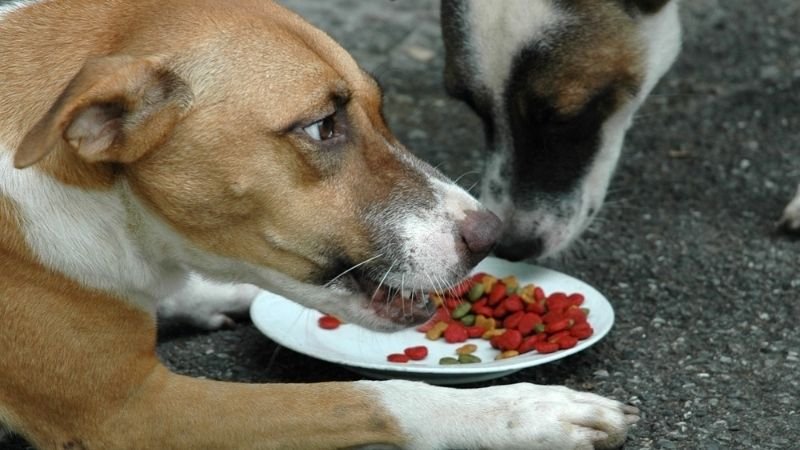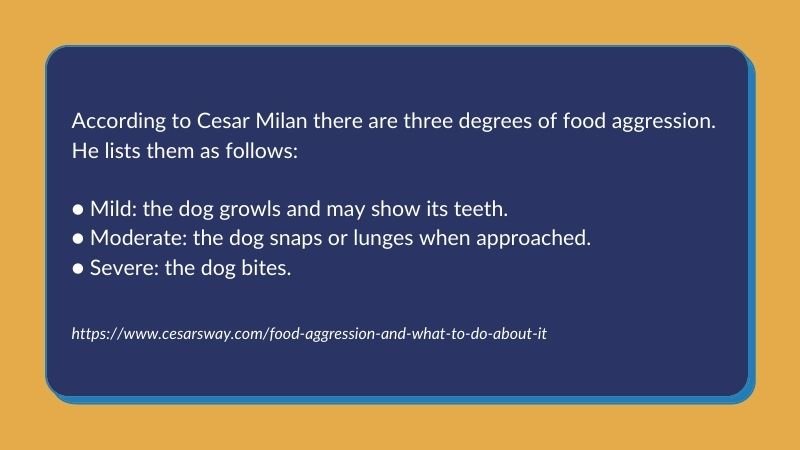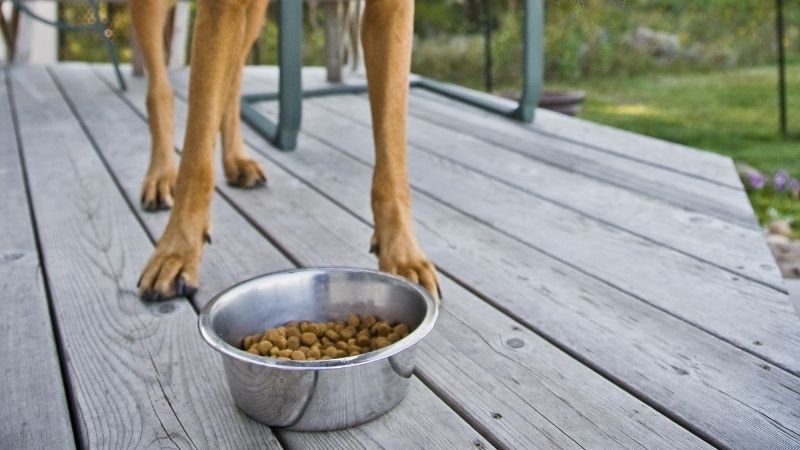Does Your Dog Behave Strangely Around His Food Or Favourite Things?
Your dog is sweet and friendly most of the time but when you get too close to her food, her spot or her favourite things something changes – she starts acting weird. As a dog trainer, I hear about otherwise “good” dogs who become protective or seemingly aggressive over their food or things all the time. This behaviour is usually called “food aggression” but, for reasons we’ll get into below, I prefer the term “resource guarding.”
Why Resource Guarding Instead Of Food Aggression?
The term “food aggression” doesn’t cut it for two reasons. First, the “weird” behaviour exhibited by your dog may not only happen around food. Your dog could be guarding the favourite toy, a blanket, or even a particularly comfy spot on the couch. Second, the behaviour isn’t necessarily aggressive. In fact, the most common reason for dogs to be guarding their food is insecurity or fear.

When dogs growl (a common example of resource guarding behaviour) you might assume it is a show of aggression or dominance. In some cases, of course, you could be right. For example, if you have an alpha dog (a dog who naturally likes to lead or dominate) and your position as pack leader isn’t firmly established, your dog could be trying to claim the spot of top-dog. This isn’t usually the case. More often you have a “middle of the pack” kind of dog who is feeling insecure, anxious, or fearful and trying to protect what they feel they need to be healthy and happy.
Remember, in the wild, dogs never know where or when their next meal will be, so it’s very instinctual for them to gobble up whatever food there is whenever they have it — and to protect it from anything that approaches. Resource guarding tends to be more about protection (“Don’t take this from me!”) than aggression (“Give this to me!”). This is why I prefer the term resource guarding to food aggression.
What Does Resource Guarding Look Like?
Whether your dog is guarding food or a beloved toy, resource guarding often includes some or all of the following behaviours:
- A dog that growls, snaps, curls its lip or shows teeth while hovering over its food, toy, treat, spot or even human
- A dog whose body tenses or stiffens and whose head is down, ears are back and whose tail is lowered
- A dog who’s showing the whites of its eyes
- A dog whose hackles (hair on the back of his or her neck) are raised
In addition to these common signs of resource guarding, a dog whose behaviour is more severe may growl, lunge, or even bite anyone (human or animal) that comes between him and his food or another resource. This is one reason resource guarding needs to be addressed sooner, rather than later.

Deciding How To Address Your Dog’s Behaviour.
It is important to address resource guarding behaviour as soon as you notice it especially if you are fearful of being bitten. It is unlikely to resolve on its own and the more severe it becomes, the harder it can be to correct. The first step towards correcting resource guarding is figuring out why it’s happening in the first place.
Every dog is different. Before trying to correct your dog’s behaviour there are some things you should figure out.
- Assess your dog’s overall confidence and behaviour.
Ask yourself if your dog is naturally a dominant dog. If he is, then you will need to assert yourself as the Pack Leader in a calm and consistent way. On the other hand, if your dog is timid or fearful, you will need to build up his confidence and teach him that his food is safe with humans around.
- Determine whether your dog’s food resource guarding behaviour is mild, moderate, or severe.
For severe resource guarding behaviours – especially if the dog is likely to bite – you and your dog may benefit from working with a professional right from the start.
- Determine If your dog is guarding food specifically or his resources in general.
If the behaviour isn’t limited to food, then your dog is showing general resource guarding. This will affect the tools and rewards you use while training to correct the behaviour.
Whether your dog’s behaviour stems from its need to assert dominance or from its anxiety, you have to teach the dog that you are in control of the resources. As the pack leader, you will provide him with the resources he needs – it is not something your dog needs to be in control of. For anxious dogs, this will build their confidence and trust in you. For dogs who are trying to assert themselves as the pack leader, it shows them their place and tells them you’ve got this – you are the leader.
When A Sock Isn’t Just A Sock: Assessing Your Own Role In Resource Guarding
It’s important to realize that guarding behaviour (especially food aggression) is a learned behaviour. For some dogs (a stray or rescue, for example) it manifests as a survival strategy. They may have come from a place where food was scarce and protection was necessary. For others, guarding behaviours are created by your actions (and reactions) as the dog owner.
As the owner and leader, your actions teach your dog a lot more than you may realize. For example, if you have reacted to your dog chewing on a sock or shoe by grabbing it away and making a big show of protecting (you might even say guarding) the sock, you are teaching your dog that it must be a very valuable resource. To a dog, the sock is just a sock…until you show him otherwise.
Pause before you react. Instead of grabbing the sock away, speak to your dog in a cheerful tone to get his attention. Then, offer him something even more valuable to chew on. You can work on training your dog not to chew on socks in another moment. Measure your response and think before you act. Don’t let your knee-jerk reactions create unwanted behaviours in your dog.

How Do You Correct Resource Guarding? Some Dog Training Tools To Get You Started.
Whether it is food aggression or more general resource guarding, changing your dog’s behaviour will require training. As Cesar Milan explains:
“In rehabilitating a food aggressive dog, two things are happening. One is that you’re desensitizing your dog so that she will no longer become protective when anybody approaches her while she’s eating. The other is that you’re counterconditioning your dog by teaching her to associate people approaching her bowl with good things.”
Below you will find some strategies and tools to help you begin correcting your dog’s resource guarding.
Being Consistent Is Critical For The Anxious Dog.
For an anxious or fearful dog, part of their guarding behaviour may be tied to stress about when his next mealtime (or playtime, or snuggle time) is going to be. If your dog seems to be resource guarding because of anxiety or fear be sure that you are feeding your dog at the same time every single day. Dogs have a very good internal clock, and with consistency, they quickly learn how to
tell when it’s time to get up, time to go for a walk, or time for the people to come home. Mealtime should be no different. Be regular in feeding to reduce or eliminate the anxiety.
Make Your Dog Work For His Food (Or Toy)
Try feeding your dog after a walk or training session instead of before. Dogs like to feel like they are useful and have a place in the pack. Feeding after completing an activity helps to fulfill that need and can make your dog feel like she earned the meal. It’s like giving your pooch a pat on the back for a job well done – but more valuable.
Teach Your Dog That You And His Meal Are A Package Deal.
Before you even begin to prepare your dog’s food, make her sit or lie down and stay. If you can have the dog do this just outside of the room or space you feed her in, that’s ideal. Set the bowl down and stand directly next to it, then release her from her sit. To get the food, she is going to have to accept that you are there next to it. Once she starts eating happily, you can move away.
Remind A Dominant Dog Who’s The Leader Of Your Pack By Having Her Eat After You.
In a dog pack, the leader eats first. If you need to reassert yourself as pack leader to help correct resource guarding, this is a good place to start. You eat your dinner first and when you are done, you can offer dinner to your dog.
Convince Your Dog That Having You Near Their Food Dish Is What They Want.
If your dog is guarding their food (or toy, for that matter) they “win” every time you back away because of their guarding behaviour. So, change the game by having them want you near their bowl, toy or favourite sunny spot. To do this you can try:
- Hand-feeding your dog treats or kibble both away from their bowl and next to it.
- Using your hands to fill their food bowl (this gives their food your scent)
- Drop a treat or two in your dog’s bowl while they are eating or next to their toy while they are playing. This helps them to learn that someone approaching them and their precious resource is not a bad thing.
- Show your dog that it’s safe to let their guard down when you approach – no one is going to take their food or toy. For example, when they are eating their regular food approach with a special treat. When they stop eating to accept your treat they are learning that you aren’t there to steal their food and that it is safe to let their guard down while eating.
The approach you choose will depend on what resources your dog is guarding, how severe their behaviours are and why you think they are behaving this way to begin with. There is no one size fits all solution for resource guarding. However, with training and patience, you can teach your dog to let its guard down and change its behaviour.
Resource Guarding Can Be Corrected With Training And Patience.
Resource guarding is a sign that something is up with your dog. They are trying to tell you something. Whether the root cause of the behaviour is anxiety or an attempt to assert dominance, the balance in your relationship with your dog is off. Help show your dog that the resources they need – be it food or toys – are not something they need to be in control of or worried about. You have things under control and will provide for them. Take the time to understand why your dog is behaving this way and choose training strategies that you can implement consistently. If you aren’t sure where to start, tell us about your dog and let’s see how we can help
